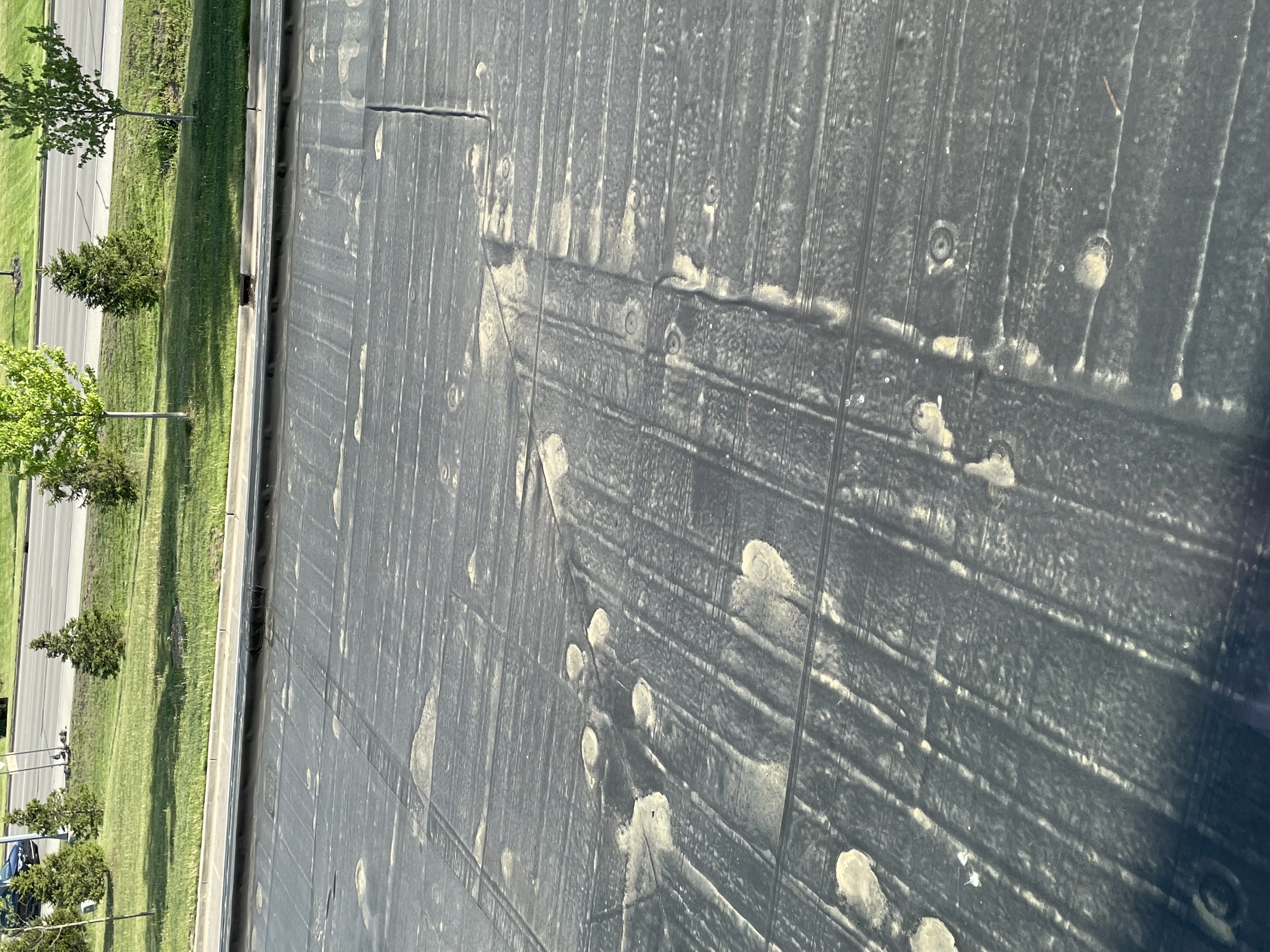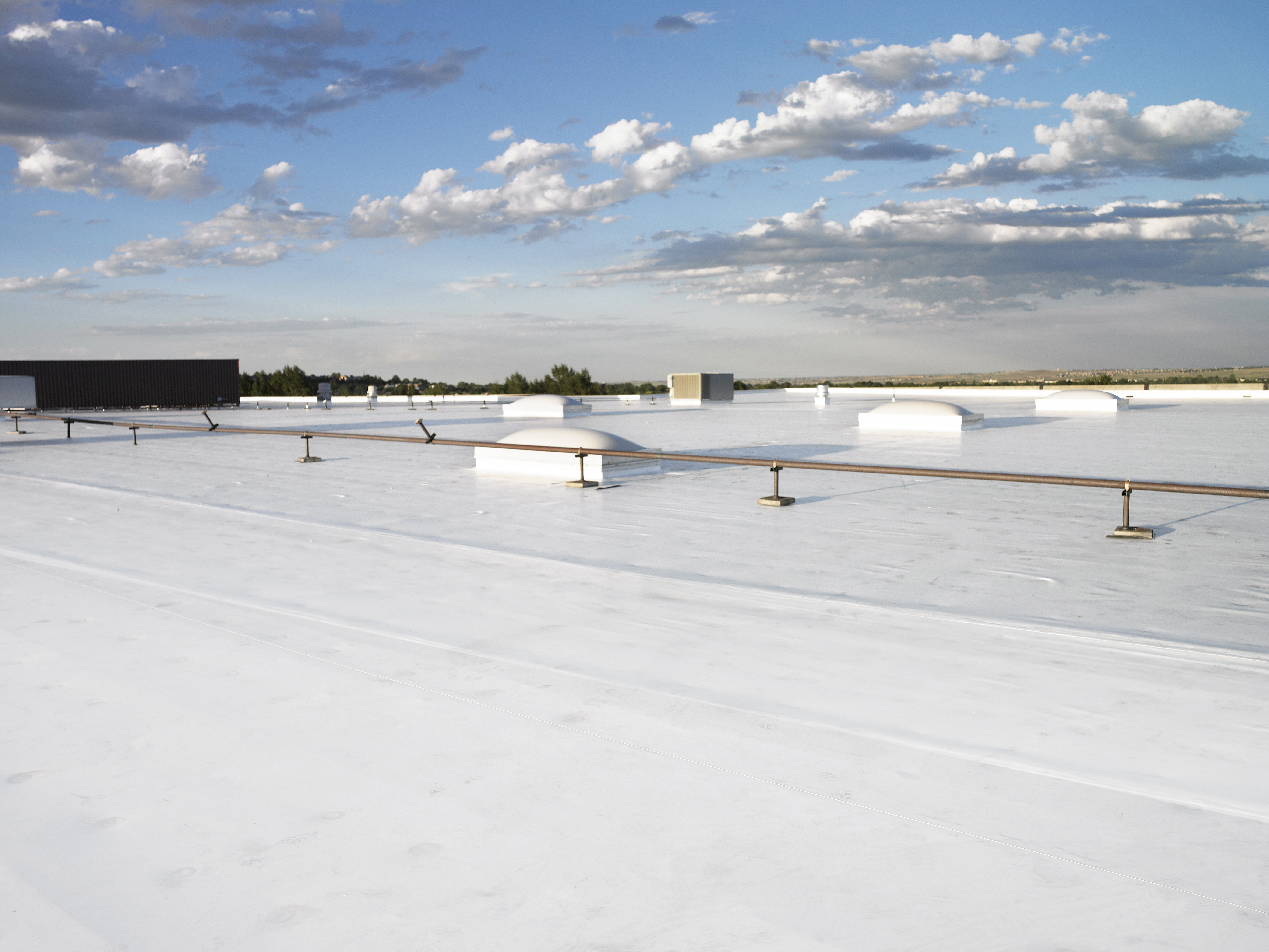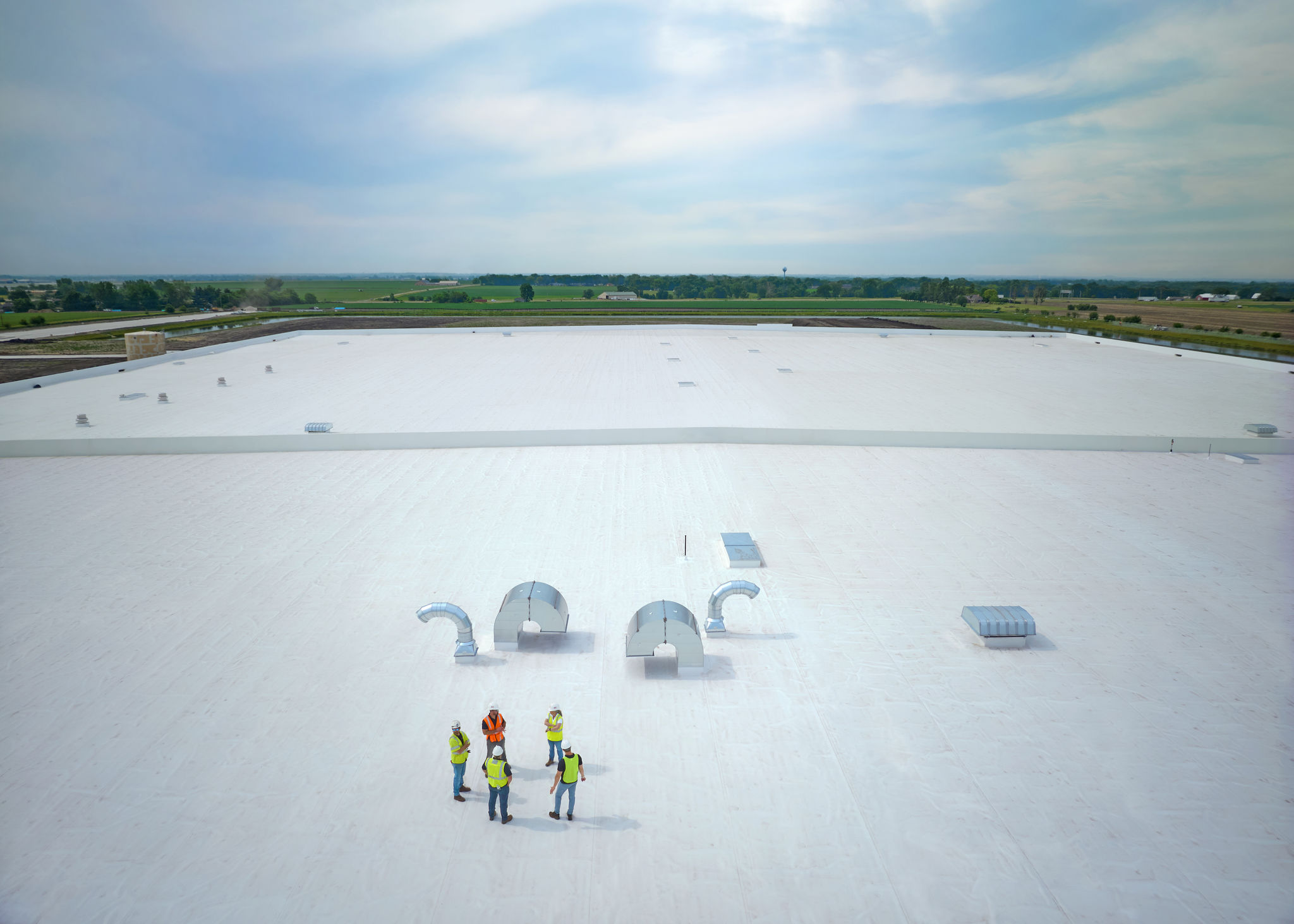Right Roof = Right Requirements + Right Materials + Right Place
Modified Bitumen
Created in Europe in the 1960’s, modified bitumen is a modern day built-up roof that consists of the same asphalt plies, but instead of building the plies on the roof, they are produced in rolls in a factory. Modified bitumen roofs offer the same durable protection of a built-up roof with a faster and more consistent installation since the rolls are pre-manufactured offsite. Modified bitumen roofs have a base ply and a granulated cap sheet (called a two ply system), where the cap sheet has embedded granules that provide an excellent wearing surface. The multiple plies create a robust system where the completed thickness can be more than 200 mils.
Bitumen, another word for asphalt, is modified by two main polymers, hence the name modified bitumen. Modified bitumen roofs are either SBS (Styrene Butadiene Styrene), which is modified by bitumen rubber polymers or APP (Atactic Polypropylene) which is modified by plastic polymers. The modified bitumen is placed on reinforcement in the factory and manufactured into rolls or ‘sheets’. Due to the two polymers that modify the asphalt, the sheets behave slightly differently and can be installed in various methods. Synthetic rubber allows the SBS sheets to achieve greater elongation ratings than other asphaltic systems. SBS systems also have the widest range of application methods as they can be hot-mopped, cold-applied, torch applied, or self-adhered. APP is typically only torch applied. Both systems have several layers for redundancy, and the cap plies can be covered in granules of various colors, including white for increased reflectivity.
With the wide variety of installation method options, modified bitumen is a robust roofing solution that can be adapted for many applications. For existing buildings where fumes from hot mopping or a torch application may be a concern, cold-applied or self-adhered installation methods are alternatives. Additionally, there are available liquid flashings that can be installed with modified bitumen systems. Liquid flashings are ideal for odd shaped penetrations and areas that are difficult to flash due to a high number of penetrations in one location or if there is limited accessibility.
Performance highlights:
- Faster to install than BUR.
- Redundancy to protect against moisture intrusion, damage (2-3 plies).
- Available with highly reflective granules on the cap sheet for energy savings.

Modified bitumen torch applied (left) and cold applied (right).
EPDM (Ethylene Propylene Diene Monomer)
EPDM was first introduced to the automotive industry in the 1960’s and is often referred to as a rubber roof. EPDM quickly gained popularity due to its ease and speed of installation as it is manufactured in rolls that are shipped to the site and rolled onto the roof with no additional membrane layers required. Currently, EPDM roof installations account for approximately 15 percent of the commercial roofing market. EPDM is typically black in color due to its ingredient of carbon black. However, white EPDM is available often at an increased price and decreased UV resistance when compared to black EPDM.
EPDM is available in large sheets, which are flexible and bend easily at transitions making it easy to install. Seams between sheets must be glued or taped, which can lose adhesion over time, especially if not prepared properly during installation. Additionally, EPDM is prone to shrinkage over time, which can put stress on the glued or taped seams. EPDM has poor resistance to acids, greases, oils, and is incompatible with asphaltic products. Compatibility for any potential chemicals on the roof should always be confirmed.
EPDM is typically manufactured in thicknesses of 45 to 90 mils and is versatile in its attachment method as it can be mechanically attached, ballasted or adhered, which makes it ideal for a wide range of applications.
Performance highlights:
- Available in very large sheets.
- Very flexible and easy to bend at transitions.
- White EPDM is available but with added cost.

Black EPDM roof.
TPO (Thermoplastic Polyolefin)
TPO membranes were first introduced into the roofing market in the early 1980’s and were standardized with the creation of ASTM D 6878 in 2003. Currently, TPO has greater than 50 percent of the low-slope commercial roofing market share due to its speed and ease of installation.
TPO membranes consist of three main components: a UV resistant cap, a core (reinforcement scrim), and a base. These three components are fused together during the manufacturing process. The cap and the core consist of similar components, but the cap contains UV stabilizers, which provide long-term weathering resistance. TPO is inherently flexible and dimensionally stable over time. Due to its chemical composition, TPO is naturally fungal resistant and has generally good resistance to chemicals. However, acids, greases, and oils should be avoided. Compatibility for any potential chemicals on the roof should always be confirmed.
TPO is manufactured in rolls that are shipped to the site and rolled onto the roof with no additional membrane layers required. After the membrane is rolled out onto the roof, the seams are heat welded together. The seam becomes monolithic and is the strongest component of the roof. TPO membranes are typically white in color, but can be manufactured in a range of standard and custom colors, including various reflective colors other than just white. TPO is typically manufactured in thicknesses of 45 mil, 60 mil, and 80 mils and they can be mechanically attached, adhered, ballasted, and induction welded. The wide range of thicknesses and installation methods make TPO a versatile choice for a wide range of applications.
Performance highlights:
- Strong, heat-welded seams.
- Inherently flexible, contains no plasticizers.
- Will not gray over time and has no fungal growth in warm climates.

Completed TPO Roof.
PVC (Polyvinyl Chloride)
PVC roofing was created in Germany in the 1960’s and was subsequently introduced to the US in the 1970’s. This single-ply membrane is flexible which allows for easier detailing. PVC also offers increased chemical resistance compared to EPDM and TPO. PVC has a steady market share due to its increased resistance to oil, grease, and chemicals.
Similar to TPO, PVC membranes consist of three main components: a UV resistant cap, a core (reinforcement scrim), and a base. These three components are fused together during the manufacturing process into rolls. The rolls that are shipped to the site and rolled onto the roof with no additional membrane layers required. After the membrane is rolled out onto the roof, the seams are heat welded together. The seam becomes a monolithic component of the two seams and is the strongest component of the roof. PVC membranes are typically white in color, but can be manufactured in a range of standard and custom colors, including various reflective membranes other than just white. PVC is typically manufactured in thicknesses of 50 mil, 60 mil, and 80 mil and they can be mechanically attached, adhered, ballasted, and induction welded.
PVC membranes consist of a liquid plasticizer that enables the membrane to become flexible. Over time, the liquid plasticizer can leach from the membrane and cause the membrane to become rigid again, allowing the membrane to crack under stress or movement. While this was a concern with earlier PVC membranes, often the plasticizer does not completely leach from the membrane prior to the end of the expected useful life of modern membranes. However, in extreme climates, this may be a design consideration. PVC is incompatible with asphaltic products which cause the plasticizers to leach out. As with any roofing membrane, compatibility for any potential chemicals on the roof should always be confirmed. Over time algae and mildew may grow on the membrane surface largely due to the migration of the liquid plasticizers, which can impact reflectivity.
Performance Highlights:
- Excellent resistance to oil and grease.
- Very flexible during installation, good for detailing.
- Reflective colors available.
PVC KEE is a variation of a PVC membrane that includes a KEE solid plasticizer. KEE (Ketone Ethylene Ester) enhances the membrane so that it is more resistant to UV degradation. KEE is a solid plasticizer that does not leach from the membrane over time, and keeps the membrane inherently flexible. PVC KEE also has best in class resistance to chemicals including jet fuel, oils, and greases, and is ideal for restaurant or airport roofing applications.
Performance Highlights:
- Better long-term weathering.
- Best in class resistance to oil and grease.
- Remains flexible over lifecycle.

Completed PVC roof.









